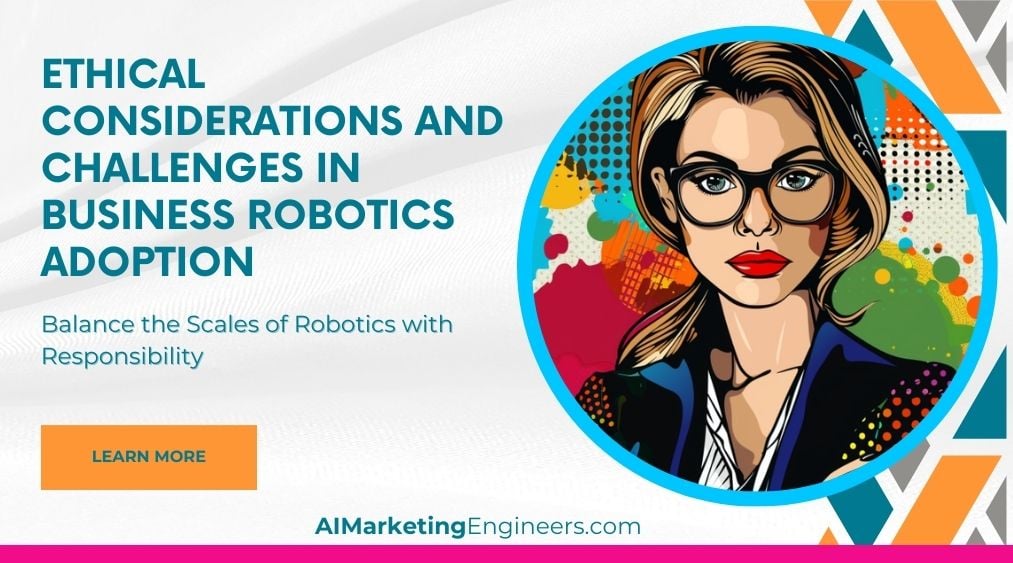Key Takeaways
✅ Transparency and Accountability: Opening the hood of robotic systems to peek inside is a must. What good is a sleek robotic worker if you can't trust the decisions it makes? We'll show you how to ensure robots in your business are fair and held responsible for their actions.
✅ Human-Robot Interaction (HRI) and Employment Impacts: Robots taking jobs is a fiery issue. But what if they could work with us, not against us? Striking the right balance could mean a future where robots and humans collaborate seamlessly.
✅ Privacy and Data Protection: In a world buzzing with data, protecting personal information is like guarding a treasure. We'll navigate the choppy waters of data use and privacy, so your robotic fleet doesn't become a pirate in the eyes of customers.
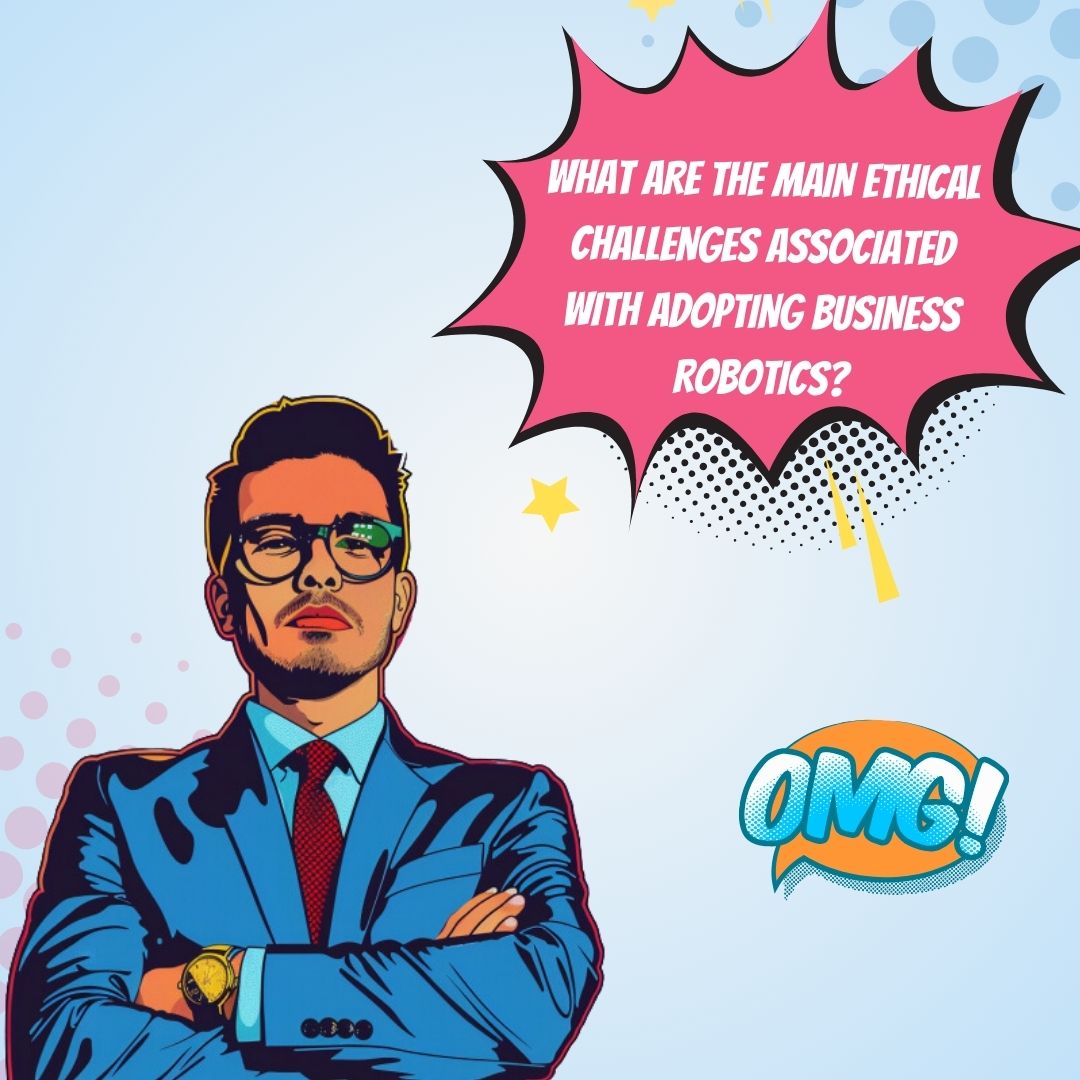
Introduction
Ever wonder what the future of work looks like? Picture this: a place where robotics and humanity meet, creating a blend of efficiency and ethical dilemmas. This isn't a journey through outer space—it's the new reality of business, happening right here, right now. It's a world where artificial intelligence (AI) shakes hands with your company's core values—a world full of promise but sprinkled with pitfalls.
We're talking about Ethical Considerations and Challenges in Business Robotics Adoption. This article peels back the layers of what this technology means—not just for your bottom line, but for the fabric of society. How do you make sure you're not stepping out of line as you step into the future? How do you harness the power of robotics without losing the human touch? We're about to take a deep dive into the marriage of mechanics and morals, unlocking pockets of potential while steering clear of the potholes.
Get ready for a rollercoaster ride into the heart of tomorrow's business. We promise it's not just going to be insightful—it's going to be actionable. Ready to delve into a treasure trove of strategies and thought-provoking perspectives on maximizing revenue, ROAS, and ROI ethically? Keep reading, because we're about to flip the switch on some perspectives you've probably never considered. And who knows? You just might become the trailblazer who sets the new gold standard in ethical business robotics. Let's gear up and go explore this brave new world together.
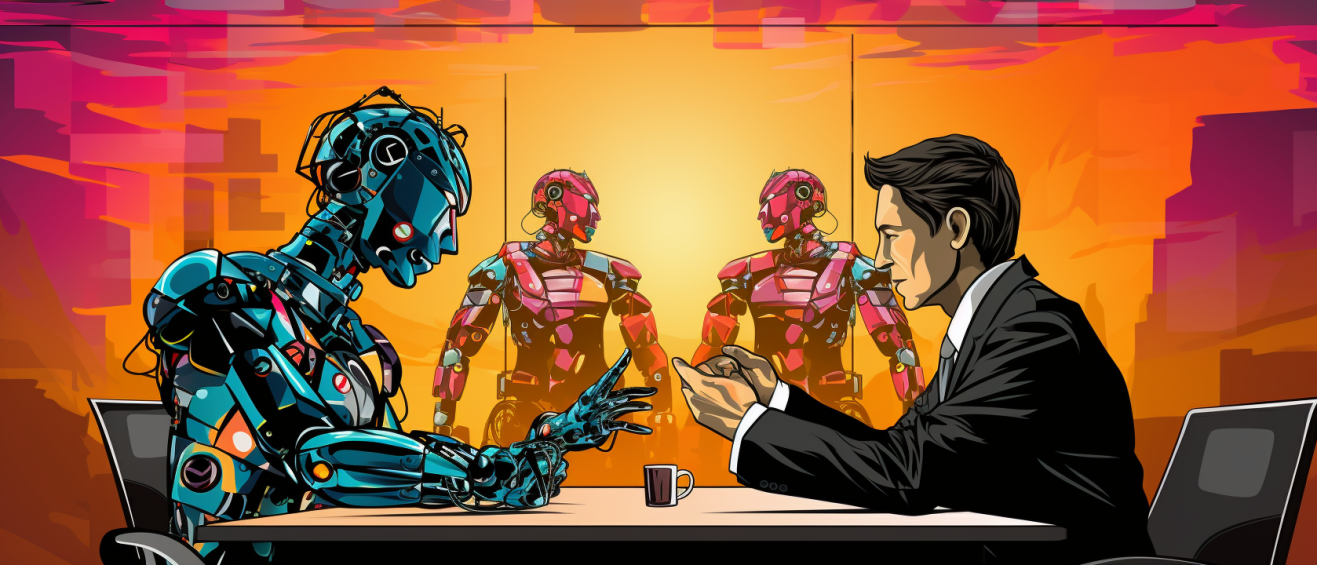
Top Statistics
| Statistic | Insight |
|---|---|
| Global Robotics Market Size: Expected to grow from $76.6 billion in 2020 to $176.8 billion by 2025. (Source: MarketsandMarkets) | This impressive growth trajectory highlights how robotics are becoming a cornerstone of modern industry, with a compound growth rate you can't ignore. |
| Industrial Robotics Adoption: An estimated global operational stock of 2.7 million units in 2020. (Source: International Federation of Robotics) | The integration of robots in industries is scaling at a steady pace, edging us towards a future where automation is the norm, not just a novelty. |
| Ethical Concerns in Robotics: 54% of business leaders view ethical issues with AI and robots as significant concerns. (Source: PwC) | Over half the boardroom is wrestling with the ethics of automation, a clear sign that this conversation is not just about wires and code, but about right and wrong, too. |
| Collaborative Robotics Market Growth: Predicted growth from $848.7 million in 2020 to $7.8 billion by 2027. (Source: Research and Markets) | The leap in collaborative robotics is telling us loud and clear: working alongside robots isn't the future; it's the now. |
| Public Perception of Robotics: 65% of Americans think robots will do much of the work currently done by humans within 50 years. (Source: Pew Research Center) | People are expecting big changes. The stats here suggest a world where robots might be the new colleagues or even the new bosses. Time will tell, right? |
Ethical Considerations in Job Displacement Due to Robotics
Have you ever thought about how job displacement affects real people when businesses adopt robotics? It's a concern that's as old as the Industrial Revolution itself, but with modern robots taking over tasks, the ethical stakes seem higher. Imagine being skilled in a job you've done all your life, only to find out a machine can now do it, potentially leaving you out in the cold. It's not just about finding new jobs—it's about dignity and the fear of becoming obsolete. Businesses must consider this and invest in reskilling and upskilling programs to help workers pivot to new roles within the digital landscape. After all, isn't it our duty to take care of our own before we chase the next technological breakthrough?

Robotics and Privacy: The Unseen Eyes
Let's talk about something that holds immense value in our lives—our privacy. When robots collect data, they could be gathering heaps of personal information. But where does all this data go? The worry about privacy concerns and data security is real. Imagine a robot in a retail store tracking your every move—kind of unsettling, right? This is where the importance of transparency steps in. Companies must be crystal-clear about how they manage and use the data collected by their robotic helpers. Robust data security measures are not just a good practice; they're a pledge of trust to the customer, one that could make or break a relationship.
Safe Interactions with Robots: More Than Just Machinery
Robots aren't just gears and coding; they interact with humans and that brings a whole new set of ethical considerations. How do we ensure that human-robot interactions don't go south? Imagine a malfunctioning robot in a factory—it could be a life or death situation. That's why designing robots that are user-friendly and embedding comprehensive safety protocols is not just important—it's essential. Creating safe spaces for humans and robots to work together enriches the workplace and protects everyone involved. In this dance between man and machine, no one wants to step on anyone's toes.
Who's To Blame? Accountability in Robotics
Navigating the tricky waters of liability in robotics-related incidents is like solving a complex puzzle where each piece represents a different concern. When a robot makes a mistake, who takes the blame—the manufacturer, the programmer, or the user? The need for clear guidelines and smart regulations has never been more pressing. Both the industry and government have to hammer out who's accountable because, at the end of the day, we can't just point fingers at the robots, can we?
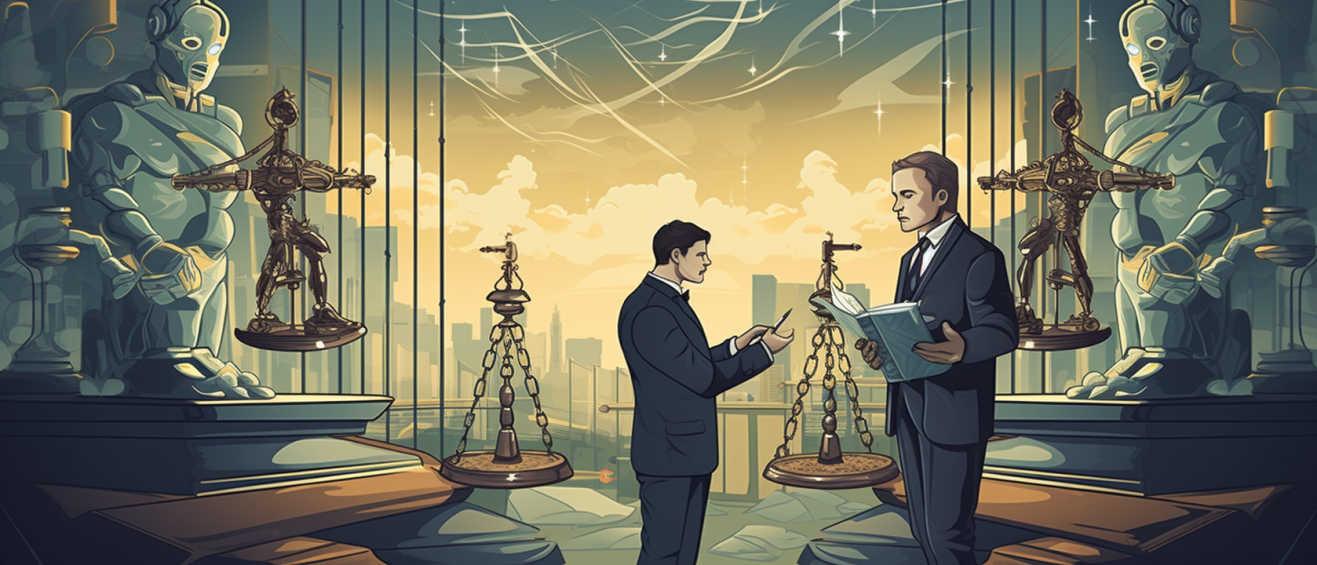
Ensuring Social Equity in the Age of Robotics
The rise of business robotics could either bridge or widen the social divide. How do we guarantee that the benefits of robotics don't only accrue to the well-off? Robotics has the potential to create a level playing field, but only if access to this technology is equitable. The concept of social impact and equity rings hollow if the advancements only serve a select few. What we need is a concerted effort to ensure that the benefits of robotics are as inclusive as the society we aspire to be.
Each aspect discussed here pivots on the fulcrum of ethics. In the excitement and rush towards progress, listening to the heartbeat of humanity and its concerns can make the difference between a future we all want and one we're afraid to face. The key is to mold the robotics revolution with a sense of responsibility and an ethical compass that ensures technological advances uplift society, not divide it.
AI Marketing Engineers Recommendation
Recommendation 1: Establish a Transparent Robotics Policy: Before jumping into the world of business robotics, let's take a moment to think about trust. Yeah, trust – the cornerstone of any solid relationship, right? So, how do we build that with robots buzzing around? Here's the scoop: start by crafting a crystal-clear policy that lays out how robots are going to fit into your business. Back this up with data showing how they can boost efficiency and productivity, but don't shy away from the hard talks, like what it means for your workforce. Transparency isn't just a buzzword; it's the key to getting everyone on board, from your employees to your customers. Show them that you've thought about the big picture – how robots will play fair and square in your company.
Recommendation 2: Emphasize Ethical AI Training: Now, getting robots to play nicely and ethically in the business sandbox is no small feat. It's all about the training – but not just any kind of training: we're talking ethical AI training. Keep abreast of how top companies are staying woke to the ethical side of AI. These savvy players aren't just programming for performance; they're injecting a healthy dose of values and ethics into their bots. By aligning with ethical guidelines and making sure robots can make decisions within this framework, you're not just avoiding potential pitfalls; you're setting the stage for long-term trust and reliability. And hey, nobody wants a robot that plays dirty, right?
Recommendation 3: Implement Regular Ethical Audits: Picture this: you've got this whole ethical robotics game plan rolling out smoothly, but how do you keep it on the straight and narrow? Simple: dial in regular ethical audits. These are like your robot's report cards, assessing its ethical fitness and spotting any red flags before they snowball into PR nightmares. Link these audits with relevant industry standards and compliance measures, and you'll not only play defence but also show your customers and competitors that you're serious about doing the right thing. And that's not just good ethics; it's good business. Plus, staying on top of these audits means you can tweak and nudge your strategy in real-time, keeping your robots as the good guys on the company floor.
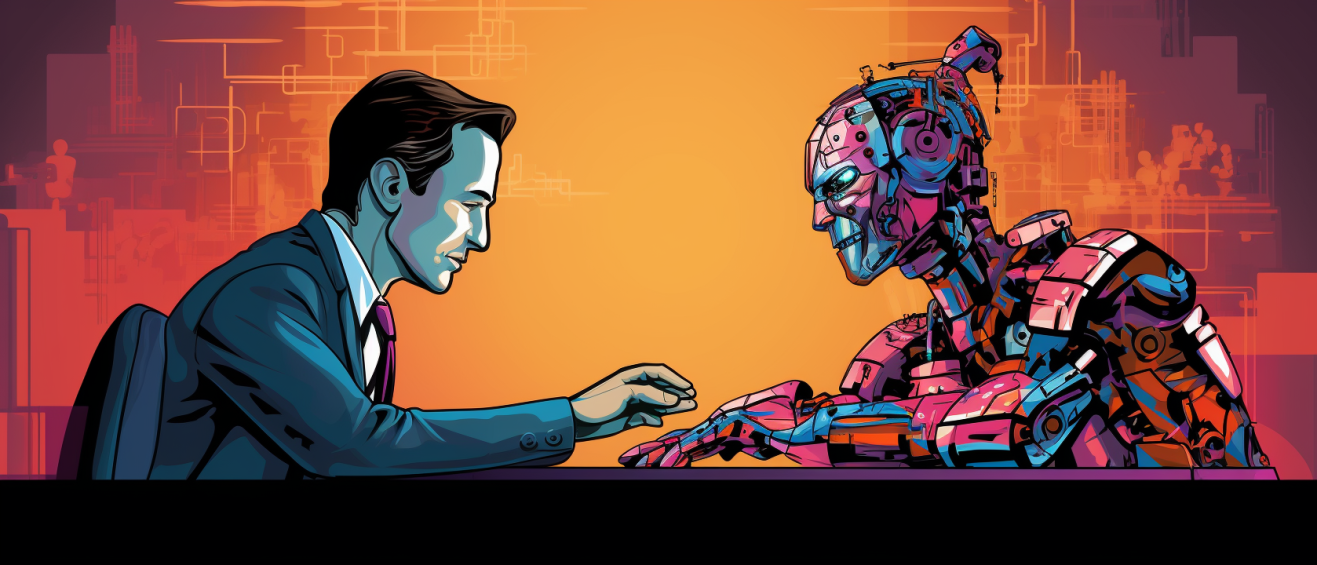
Relevant Links
Transform Your Career: Navigating Robotics Job Displacement
Embrace the Future: Reskilling in the Robotics Era
Data Privacy in Robotics: What You Need to Know
Securing Your Data: Robotics and Privacy Concerns
Robot-Proofing Your Workplace
Enhancing Safety: Integrating Robots in the Workspace
Who's Responsible When Robots Err?
Assigning Blame: The Conundrum of Robot Liability
Social Equity in the Robotic Age
Bridging the Gap: Robotics for Social Equity
Conclusion
So, we've wandered through a world where robots are more than just machines, right? They're becoming our coworkers, our helpers, and even our decision-makers. It's kind of amazing, but also, let's face it, a little bit nerve-wracking. As we've seen, robots have the power to shake up our workplaces, potentially nudging some folks out of jobs. But on the bright side, they could also open the door to new opportunities and skills for us humans. Shall we just sit and wait to see what happens? Or do we roll up our sleeves and prepare everyone for this new chapter?
We can't ignore that these mechanical buddies come with a heap of questions about who gets a peek at our data and how to keep it safe. And how can we forget? Our interactions with them need to be friendly and safe, because who wants a clumsy robot around?
Now, let's think about who's going to own up when things go awry with robots – we need crystal clear rules and some serious chatting between the folks making these bots and those making the decisions up in the government. Lastly, the beep-boop of robots shouldn’t be just for the lucky few. How can we make sure these tech wonders don’t leave anyone behind and are shared right across society?
We’ve covered a lot, and yet, this conversation is just starting. It's like we’re at the edge of a cliff, ready to dive into an ocean of possibilities with business robotics. It might be a bit scary, but also exhilarating, don't you think?
Everyone—the big guns in the industry, the policy makers, and even us ordinary folk—needs to keep talking, keep planning, and yes, keep dreaming of a future where robots make life better for all of us.
What's your take, then? Are we ready to embrace this robotic revolution with clear minds and open hearts, looking out for each other every step of the way? It’s a big call, but one that could lead to an even bigger future. The clock's ticking – let’s make sure we're all on board for a fair, safe, and ethical roll-out of our new robot companions.

FAQs
Question 1: What are the primary ethical considerations in business robotics adoption?
Answer: When adopting business robotics, we need to think about a few important ethical issues. These include the effects on jobs, how we respect people's privacy, making sure we’re clear and responsible about what the robots are doing, and avoiding unfairness in AI choices.
Question 2: How does job displacement affect the workforce, and what are the ethical implications?
Answer: Job displacement can really shake things up, leading to folks being out of work or having to take lower-paying jobs, and it might even cause social troubles. The ethical side of things is about businesses not forgetting their teams; they need to provide chances for re-skilling and think about how robots and humans can work together in new kinds of jobs.
Question 3: What are the privacy concerns associated with business robotics adoption?
Answer: Here's the thing: robots can handle tons of data, and if we're not careful, that might stretch or break privacy bounds. The right thing to do is keep this data safe and private, following the laws that protect our personal info.
Question 4: How does transparency and accountability factor into business robotics adoption?
Answer: Trust is everything, right? To get that, businesses need to be open about how they use data and make sure any decisions made by AI are clear and something you can pin responsibility for.
Question 5: What is the potential for biased decision-making in AI-driven business robotics systems?
Answer: Just like humans, AI can be biased, too—picking up on and even magnifying the biases it learns from. It's crucial for businesses to check that the AI is learning from a fair mix of information and keep an eye out for any unfair choices the system might start making.
Question 6: How can businesses ensure responsible and ethical robotics adoption?
Answer: Businesses can stay on the ethical path by laying down some rules about what’s right and wrong, regularly checking that everything's above board, talking with everyone involved, and making sure their people know what’s what as things evolve.
Question 7: What is the role of government regulation in business robotics adoption?
Answer: The government steps in to set the rules of the road for ethical robot use, tackling tough issues like the impact on jobs, keeping data private, making sure actions are clear and accountable, and laying down the law for how to adopt robots the right way.
Question 8: How can businesses balance the benefits of robotics adoption with potential ethical concerns?
Answer: To hit that sweet spot, businesses should weigh up the risks, get input from people who care, and make learning about robotics an ongoing thing for their teams. They need to be guided by clear ethical principles and check in regularly to stay on track.
Question 9: What are some best practices for responsible and ethical business robotics adoption?
Answer: It's all about being thorough in checking risks, chatting with stakeholders, helping teams learn continuously, sticking to ethical rules, and doing regular check-ups to make sure robots are being used in the right way.
Question 10: What resources are available for businesses and professionals interested in learning more about ethical considerations in business robotics adoption?
Answer: For those keen to dig deeper, there are industry groups, research papers, government tips, and organizations focused on keeping AI and robots on the straight and narrow.

Academic References
- van Wynsberghe, A., & Sharkey, N. (2012). Ethical and Social Implications of Robotics: A Literature Review. Science and Engineering Ethics, 18(4), 685-700. This review article takes a deep dive into the moral and social questions that come up when robotics enter the business scene. They talk about the big need for rules and guidelines to make sure we cover privacy, safety, and who's responsible when things go wrong. Think about it: how would you feel if a robot made a big mistake at work, and nobody knew who to hold accountable?
- Jirotka, M., & Adam, A. (2018). Ethical Challenges of Robotics and AI in Business and Society. In S. O. Idowu (Ed.), Robotics and Artificial Intelligence (pp. 241-254). Springer. Imagine stepping into a future where robots and AI are everywhere in business and our daily lives. This book chapter paints a picture of exactly that and nudges people creating these technologies to think about the societal and ethical angles right from the get-go. Because, let's face it, nobody wants a future like in those scary sci-fi movies where robots take over, right?
- Tremblay, D.-G., Cohendet, P., & Simon, L. (2019). Ethical and Social Implications of Robots in Organizations: A Systematic Review. Journal of Business Ethics, 159(3), 579-597. This article carefully sorts through the maze of ethical and social questions that arise when you have robots working in an organization. Jobs might get snatched away, personal stuff might no longer stay personal, and the way humans and robots get along has to figure itself out. It's a bit like introducing new pets to each other, but with more consequences. And someone has to think about what this all means for rules and research down the line.
- El-Khalifa, A., & Morgan, N. (2019). Ethical Issues in the Adoption of Robotics and AI in Business: A Conceptual Framework. Journal of Business Research, 99, 272-281. When robots and AI start showing up in the workplace, it's not all about the cool factor – there's a whole web of ethical issues to think about. This article offers a map (well, a conceptual framework) to navigate this web, looking at stuff like transparency, who's accountable, and making sure things are fair. It's a bit like making sure everyone plays nicely in the sandbox.
- McCarthy, D. E., & Osborne, M. A. (2018). Robotics and the Future of Work: Implications for Occupations and Skills. In L. C. Jain & H. S. Lim (Eds.), Robotics and Artificial Intelligence (pp. 267-282). Springer. Here we consider what happens to everyone's jobs and skills when robots elbow their way into the workplace. It's not just about whether we can stay ahead in the race against the machines; it's also about fairness and who gets a slice of the robot-made pie. Do we all need to become robot experts now, or what? It's a conversation we should probably start having sooner rather than later.
